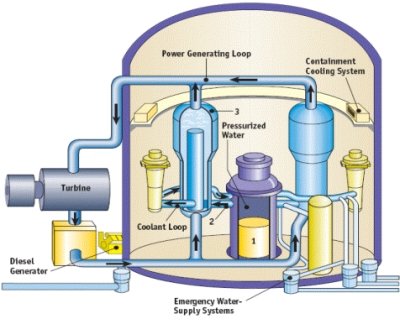Millstone Nuclear Power Station, Connecticut
Next Update: August 2009
Millstone Nuclear Power Station
Net Generation and Capacity, 2007
Unit |
Net Capacity |
Generation |
Capacity |
Type |
On Line |
License |
| 2 | 882 |
6,882.807 |
99.5 |
PWR |
Sept. 26, 1975 |
July 31, 2035 |
| 3 | 1,155 |
8,603.295 |
86 |
PWR |
Jan. 31, 1986 |
Nov. 25, 2045 |
2,037 |
15,486.102 |
91.8 |
||||
| *The license expiration date was altered to reflect a 20-year extension approved by the Nuclear Regulatory Commission on November 28, 2005. Notes: Both Millstone reactors have been up rated (increased in capacity). Unit 2 was listed as 869 net MW(e) in capacity, then revised in 2005 to 882 net MW(e). Unit 3 was previously listed as 1,131 net MW(e) in capacity, then revised in 2005 to 1,158 net and was revised again in 2005 to 1,155 net MW(e). PWR = Pressurized-Water Reactor. Sources |
||||||
Description: Millstone complex was built by a consortium of utilities. The power plant is located at a former quarry in Waterford, Connecticut. The site covers about 500 acres. Three reactors were located here, but Millstone 1 was shut down in November 1995 and never re-started. The other two units were shut down between 1996 and 1998 due to safety problems. Millstone 1 was being permanently closed in July 1998. In August 2000, units 2 and 3 were sold to their current owner, Virginia-based Dominion Resources, Inc.
Millstone, Unit 2
Nuclear Steam System Supplier (NSSS Vendor) = Combustion Engineering
Architect Engineer = Bechtel
Owner = Dominion Nuclear Connecticut, Inc.
Operator (Licensee) = Dominion Generation
Millstone, Unit 3
Nuclear Steam System Supplier (NSSS Vendor) = Westinghouse Electric
Architect Engineer = Stone & Webster
Owner = Dominion Nuclear Conn, Inc., (93.47 percent), Central Vermont Public Service Corporation, (1.73 percent), and Massachusetts Municipal Wholesale Electric Company, (4.8 percent).
Operator (Licensee) = Dominion Generation
Pressurized-Water Reactor (PWR)
In a typical commercial pressurized light-water reactor (1) the reactor core generates heat, (2) pressurized-water in the primary coolant loop carries the heat to the steam generator, (3) inside the steam generator heat from the primary coolant loop vaporizes the water in a secondary loop producing steam, (4) the steam line directs the steam to the main turbine causing it to turn the turbine generator, which produces electricity. The unused steam is exhausted to the condenser where it is condensed into water. The resulting water is pumped out of the condenser with a series of pumps, reheated, and pumped back to the steam generator. The reactors core contains fuel assemblies which are cooled by water, which is force-circulated by electrically powered pumps. Emergency cooling water is supplied by other pumps, which can be powered by onsite diesel generators. Other safety systems, such as the containment cooling system, also need power.
 |
| © U.S. Nuclear Regulatory Commission |
Containment: According to the U.S. Nuclear Regulatory Commission, both units include pressurized light water reactors (PWR). The containment for unit 3 is dry, subatmospheric.1 The constainment type for unit 2 is dry, ambient pressure.2
_________________________________________
1Dry, Subatmospheric: a reactor containment design which is held a negative (sub-atmospheric) pressure (i.e., a vacuum) during normal operations. When a pipe breaks or a steam release occurs in this design, much of the initial internal pressure rise is countered by the negative pressure that is already present. As a result, the final pressure reached is lower than that which would have occurred if the containment had started out at zero psig (atmospheric pressure). NOTE: If the expected containment pressure buildup from steam in an accident is say, +10 psig; and the containment walls will burst at 8 psig; - you can eliminate the possibly of a containment failure by simply starting out at negative 5 psig instead of 0 psig. So when the accident occurs, the pressure will rise from -5 psig to just +5 psig and still be safe.
2Dry, Ambient Pressure: a reactor containment design whose safety has been evaluated on the basis of having a dry air atmosphere at ambient pressure (0 psig) prior to the onset of a loss of coolant accident or steam pipe break. The containment design (concrete and steel tendons) must be able to take the full thermal and pressure stresses associated with the rapid energy release (steam) from a major pipe break.
Sources for Data in Table: Capacity, for purposes of this report, is the net summer capability as reported in Energy Information Administration (EIA) Form EIA-860, "Annual Electric Generator Report." Capacity Factor is a percentage calculation in which the maximum possible generation (based on net summer capability) is divided into the actual generation then multiplied by 100. Generation is the net electricity output reported by plant owners on Form EIA-906, “Power Plant Report.” Type of Unit: All U.S. commercial reactors currently in operation are one of two types: BWR (boiling water reactor) or PWR (pressurized light water reactor). The type, on-line date, and the license expiration date are published annually in Information Digest by the U.S. Nuclear Regulatory Commission.